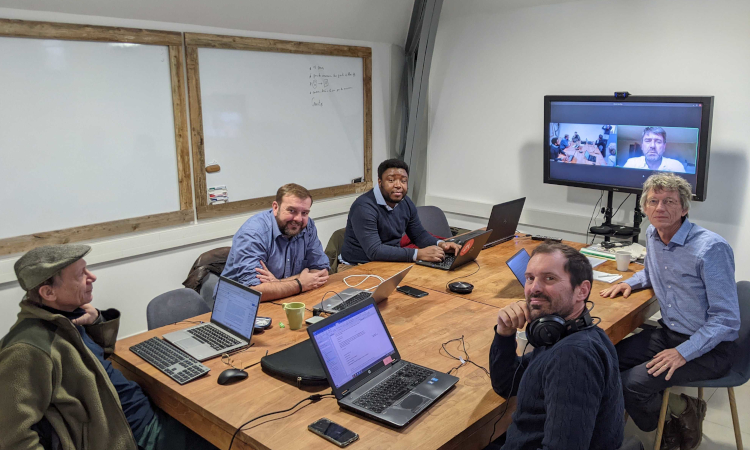AFROBIODRIVERS
African biodiversity dynamics: interactions between ecological processes and conservation actions

While Africa has been home to exceptional biodiversity so far, the proven decline of its large, iconic mammals represents a significant ecological and economic threat to most countries of the continent. When in 2010, the world’s governments committed to increasing the coverage of protected areas to 17% of the world’s land surface, several Central African countries had already established the protection of 25% of their savannas for conservation purposes.
To assess the effectiveness of these tools, researchers from the Afrobiodrivers project :
- combined data on African large mammal populations and on the causes of changes (natural, anthropogenic), in order to improve the availability and use of multidisciplinary data,
- improved methods for analyzing spatial and temporal trends of populations and identified the main drivers of change, both ecological and anthropogenic, by analyzing and modeling long-term trends,
- analyzed results from the seven main savanna national parks in Central Africa, as well as information on potential pressures impacting the large herbivore population (rainfall, number of rangers) and on the number and income of tourists.
In six of the seven parks, wild populations of large herbivores have declined significantly over time, while livestock numbers have increased and tourism, the mainstay of a once thriving local wildlife industry, has collapsed. Zakouma National Park (Chad) stood out because its large herbivore populations increased, an increase that is positively correlated with rainfall and guard numbers, shown here as a relevant conservation indicator. These trends are consistent with the original hypothesis that protected areas in which declines in large wild herbivores were observed were also those that suffered from lack of financial and human resources, and reduced socioeconomic benefits, while experiencing increased levels of insecurity.
Despite the success of Zakouma-which represents 2% of the conservation areas in Central Africa-the message is clear and serious: declines in large wild herbivore populations, massive livestock intrusion into protected areas, and collapsing tourism revenues are the results of an inordinate conservation effort in the Central African savannahs, where protected areas are too large and expensive to manage.

Figure: Total biomass of large wild herbivores (in green) and livestock (in red) in national parks in the Central African savannas, 1960-2017.

AFROBIODRIVERS members during their CESABAFTER meeting at CESAB in December 2021

PI:
Hervé FRITZ – CNRS, UCB Lyon (France)
Postdoc:
Fabrice HIBERT – CNRS Lyon (France)
AfroBioDrivers brings together experts in mammalian biology, evolutionary biology, biometrics, conservation biology and data analysis.
AFROBIODRIVERS was selected from the 2011 call for proposals. The project selection process was carried out by a committee of independent experts.
[04] Pradel R, Renaud P, Pays O, Scholte P, Ogutu JO, Hibert F, Casajus N, Mialhe F & Fritz H (2024) Establishing large mammal population trends from heterogeneous count data. Ecology and Evolution, 14, e70193. DOI: 10.1002/ece3.70193.
[03] Scholte P (2022) More is not enough: Central Africa and the proposed 30% protected and conserved areas by 2030. Oryx, 56, 810–811. DOI: 10.1017/S0030605322001090.
[02] Scholte P, Pays O, Adam S, Chardonnet B, Fritz H, Mamang J-B, Prins HHT, Renaud P-C, Tadjo P & Moritz M (2022) Conservation overstretch and long-term decline of wildlife and tourism in the Central African savannas. Conservation Biology, 36, e13860. DOI: 10.1111/cobi.13860.
[01] Mallon DP, Hoffman M, Grainger MJ, Hibert F, van Vliet N & McGowan PJK (2015) An IUCN situation analysis of terrestrial and freshwater fauna in West and Central Africa, Occasional Paper of the IUCN Species Survival Commission (No. 54), Gland, Switzerland and Cambridge, UK, 162p. DOI: 10.2305/IUCN.CH.2015.SSC-OP.54.en.
Scholte P, Pays O, Adam S, Chardonnet B, Fritz H, Mamang J-B, Prins HHT, Renaud P-C, Tadjo P & Moritz M (2021) Conservation overstretch and long-term decline of wildlife and tourism in the Central African savannas. Conservation Biology, accepted. doi: 10.1111/cobi.13860.
- Article synthesis : La conservation sur des espaces surdimensionnés et le déclin de la faune sauvage et du tourisme dans les savanes d’Afrique centrale (in French)
- French media : PFBC, Commission des Forêts d’Afrique Centrale, The Conversation, PFCB.
- International media : Ohio State News, Science Daily, Environmental News Network, Swift Telecast, Opera News, Afric.info, CBFP, Anthropocene, The Conversation, Novaator, CBFP, African American Voice, Zenger.
